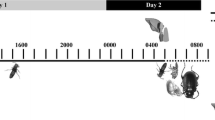Abstract
Anthecological observations of an orchidBletilla striata were carried out in Kobe, Japan. The purplish pink flowers were visited by 26 species of insects belonging to Hymenoptera, Diptera and Lepidoptera, although the flower did not offer food rewards of any kind. Candidates for pollination were seven species of aculeate Hymenoptera with a body size that well fitted the space in between the column and labellum. The most effective candidate was the male of the longhorn beeTetralonia nipponensis, judging from its abundance and legitimate intrafloral behavior. The female ofT. nipponensis and the other six species also contributed to promote out-crossing, but to a lesser extent than the maleT. nipponensis, since they occasionally exhibited illegitimate intrafloral behaviors for pollination and also, their flower visitation rate was lower.
Similar content being viewed by others
References
Calvo R. N. (1990) Inflorescence size and fruit distribution among individuals in three orchid species.American Journal of Botany 77: 1378–1381.
Dressler R. L. (1990)The Orchids: Natural History and Classification. Harvard University Press, Cambridge.
Heinrich B. (1979)Bumble Bee Economics. Harvard University Press, Cambridge.
Ishikawa M. (1968) The pollination ofBletilla striata.Iden 22: 30–34 (in Japanese).
Nilsson L. A. (1979) Anthecological studies on the lady's slipper,Cypripedium calceolus (Orchidaceae).Botaniska Notiser 132: 329–347.
Nilsson L. A. (1980) The pollination ecology ofDactylorhiza sambucina (Orchidaceae).Botaniska Notiser 133: 367–385.
Nilsson L. A. (1992) Orchid pollination biology.Trends in Ecology and Evolution 7: 255–259.
Papaj D. R. & Lewis A. C. (eds) (1993)Insect Learning: Ecological and Evolutionary Perspectives. Chapman & Hall, London.
Pettersson B. &Nilsson L. A. (1993) Floral variation and deceit pollination inPolystachya rosea (Orchidaceae) on an inselberg in Madagascar.Opera Botanica 121: 237–245.
Satake Y., Ohwi J., Kitamura S., Watari S. &Tominari T. (eds) (1982)Wild Flowers of Japan: Herbaceous Plants (including Dwarf Subshrubs) Vol. 1. Heibonsha, Tokyo (in Japanese).
Tan K. W. (1969) The systematic status of the genusBletilla (Orchidaceae).Brittonia 21: 202–214.
Tanaka H. (1990) A mystery on the honey bee visitation toBletilla striata flowers. In:Field Watching, Vol. 1. (eds S. Kawano & H. Tanaka) pp. 74–75. Hokuryukan, Tokyo (in Japanese).
Author information
Authors and Affiliations
About this article
Cite this article
Sugiura, N. The pollination ecology ofBletilla striata (Orchidaceae). Ecol. Res. 10, 171–177 (1995). https://doi.org/10.1007/BF02347939
Received:
Accepted:
Issue Date:
DOI: https://doi.org/10.1007/BF02347939




